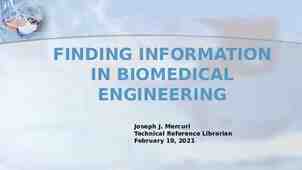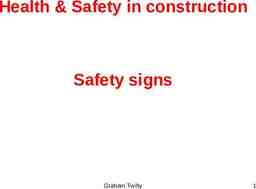Job Analysis Patricia A. Meglich, Ph.D., SPHR 2009
38 Slides476.88 KB
Job Analysis Patricia A. Meglich, Ph.D., SPHR 2009
Learning Objectives for this Session Explain the historical context of job analysis. Define the importance of job analysis to all HR activities and functions. Explain the information required to conduct a job analysis and sources of information. 2 SHRM 2009
Job Analysis Defined Job analysis is the process of studying jobs to gather, analyze, synthesize and report information about job responsibilities and requirements and the conditions under which work is performed. Modified from Heneman and Judge (2009) 3 SHRM 2009
Historical Perspective Frederick Taylor (1911) Scientific Management Replaced rule-of-thumb work methods with scientific study. Scientifically select, train and develop workers. Cooperate with workers to ensure that scientific methods are followed. Divide work such that managers apply scientific principles and workers implement them. Find the “one best way” to accomplish any task. Utilized time and motion studies to analyze tasks. 4 SHRM 2009
Historical Perspective Elton Mayo (1927-1932) Hawthorne Studies Informal organization affects productivity. Work group norms affect productivity. The workplace is a social system. Work is more than tasks and duties. 5 SHRM 2009
Organizations in the New Millennium Evolving work methods. Organization structure. Reporting relationships. Global demands. Knowledge workers. 6 SHRM 2009
Foundation of all HR practices 7 SHRM 2009
Foundational HR planning: Training: Work design. Training needs for new Skills required. employees. Training program content. Training evaluation. Staffing: Advertising in labor market. Selection criteria. Selection methods. Succession planning. Performance management: Performance standards. Evaluation criteria. Appraisal forms and methods. Feedback and communication with employees. 8 SHRM 2009
Foundational Safety and health: Employee relations: Training required. Work rules, policies and Protective equipment procedures. Clear lines of authority and responsibility. Union work settings. needed. Hazard communications. Accommodations for medical impairments. Rewards: Legal compliance: Recordkeeping. Value of each job for Accommodations. compensation purposes. FLSA status. Pay adjustments. Training. Compensation practices. Equal employment practices and affirmative action. 9 SHRM 2009
Information Collected Data, people, things. Tasks or job functions: What gets done on the job. Essential functions. Scope of responsibility: Supervision received. Supervision provided. Tools and equipment used on the job: Computer software. Hand tools. Job-related equipment. 10 SHRM 2009
Information Collected Work context and environment: Physical environment (discomfort, hazards). Work schedule (hours, days). Travel required. Social/relationship factors: Nature of social contacts. Level of social contact. Decision-making authority: Judgment and discretion. 11 SHRM 2009
Information Collected Personal and physical demands of the job: Stand, sit, reach, lift, walk. Knowledge, skills and abilities required to perform job tasks: Education. Experience. Certification (desired) and licensure (required): Certification (HR). Board licensure (physician, engineer). 12 SHRM 2009
Job Requirements Matrix KSAs Tasks Specific Tasks Task Dimensions Importance (% of time) Nature Importance to tasks (1-5) Arrange schedules with office assistant to ensure that office is staffed. Supervision 30% Knowledge of office policies and operations. 4.9 Assign office tasks to office assistant and volunteers. Supervision Type/transcribe letters, memos and reports. Word processing Knowledge of office policies and operations. 20% Knowledge of typing formats and software. 3.1 See Exhibit 4.3 on page 151 of Heneman and Judge, Staffing Organizations, 2009. 13 SHRM 2009
Data Sources Job incumbent Supervisor or manager Former jobholders Job analyst Subject matter experts (SMEs) Industry resources Professional organizations like SHRM 14 SHRM 2009
Dictionary of Occupational Titles Dictionary of Occupational Titles is now online on O*Net. Comprehensive searchable database: http://online.onetcenter.org 15 SHRM 2009
O*Net Homepage 16 SHRM 2009
End of Session I This concludes Session I. Assignment for Session II: In groups of four to five students, retrieve a job description from O*Net. Choose from the following list of job titles: Dental hygienist. Waiter and waitress. Real estate sales agent. Floral designer. Hairdresser, hairstylist, cosmetologist. Retail salesperson. Print out the job description and bring it to the next class session. 17 SHRM 2009
Learning Objectives for Session II Explain data collection methods to conduct a job analysis. Analyze a job description retrieved from O*Net with respect to sources and data collection methods. Analyze a job description retrieved from O*Net with respect to importance of tasks. 18 SHRM 2009
Data Collection Methods Observation Work sample Work diary Interview Questionnaire Perform the job Background records Multiple methods 19 SHRM 2009
Observation Directly observe job incumbents performing the job duties, work sample or job segments. Can also be observed indirectly via video or audiotape: Hazardous jobs (airline pilot, surgeon, construction). High-risk jobs (nuclear power plant). Best when job/task is repetitive and short cycle. Good for manual jobs and tasks. Not good for nonrepetitive, long-cycle jobs and tasks. Not good for creative or “thinking” jobs and tasks. 20 SHRM 2009
Work Sample Observe samples of critical job tasks. Best when job or task is repetitive and short cycle. Good for manual jobs and tasks. Not good for nonrepetitive, long-cycle jobs and tasks. Not good for creative or “thinking” jobs and tasks. Choosing the “right” or most representative tasks: Scientifically sample the job tasks to choose appropriate tasks. 21 SHRM 2009
Work Diary Description of daily activities maintained for a period of time: Calendar, day planner. Best when job or task is nonrepetitive, long cycle. Good for creative or “thinking” jobs/tasks. Requires great discipline on diary-keeper’s part. Accuracy may be questionable. 22 SHRM 2009
Interview Individual or group interviews: Job incumbents. Supervisor. Former job holders. Clients. Subject matter experts (SMEs). Generates “deep” information: Qualitative data is rich. Time-consuming and expensive. Lacks anonymity. Subject to interviewer‘s skill level. 23 SHRM 2009
Questionnaire Structured form or checklist. Paper and pencil or computer-based. Commonly used method. Standardized in content and format. Good for accessing large numbers of responses. Quantitative data. Economical. Anonymous. Downside is possible deficiency of questions/content areas assessed. Assumes incumbent literacy and intelligence. 24 SHRM 2009
Perform the Job Job analyst performs the job duties as described by job incumbent and/or supervisor. First-hand exposure to job tasks and context provides rich, relevant data. Time-consuming. Potential safety risks. Assumes a certain level of skill to perform the tasks. 25 SHRM 2009
Background Records Data mining of relevant materials such as: Organizational charts. Training manuals. Policies and procedures. Payroll records. Production records. Call sheets. A good starting point. Documents may not exist in usable form. Documents may be out of date. 26 SHRM 2009
Multiple Methods For best result, use multiple methods. Balance time and cost constraints. Balance the strengths and weaknesses of each method. No magic formula to determine how many methods are ideal or which methods to combine for a given job. Ideally, obtain both quantitative and qualitative data. 27 SHRM 2009
Job Analysis Activity I Using a job description retrieved from O*Net, you will determine the sources and methods best used to collect data to analyze this job. You will then determine the importance of each task for the job. The URL for O*Net is: http://online.onetcenter.org. 28 SHRM 2009
End of Session II This concludes the second session. Remember to bring your printed job description and worksheet for the activity to the next class session. 29 SHRM 2009
Learning Objectives for Session III Identify the outcomes of job analysis. Distinguish between essential and nonessential job duties. Explain the legal implications of job analysis. 30 SHRM 2009
Outcomes of Job Analysis Job description: Systematic, detailed summary of job tasks, duties and responsibilities. Assures that employees and managers are on the same page regarding who does what. Job specification: Detailed summary of qualifications needed to perform required job tasks. Performance standards: Establishes the level of satisfactory performance. 31 SHRM 2009
Job Description The job description should include at least the following elements: Job title. Job code. FLSA status. Job summary. Essential job duty task statements. Job context or any unusual elements. Date created. Revision number and date. 32 SHRM 2009
Job Specification The job specification should include at least the following elements: Job title. Job code. Job summary. Knowledge required to perform job. Skills required to perform job. Abilities required to perform job. Education required. Experience required. Licensure required or certification desired to perform the job. Date created. Revision number and date. 33 SHRM 2009
Performance Standards Performance standards define the level of expected quality and quantity of work produced on the job. Line managers’ input in developing performance standards is essential. Standards must be consistent and reasonable. Performance standards help the employee gauge performance on the job. 34 SHRM 2009
Essential Job Functions Americans with Disabilities Act (1990) Percentage of time spent on task: Significant percentage of time. Often 20 percent or more. Frequency of task: Task performed regularly? Daily, weekly, monthly. Importance of task: Does the task affect other parts of the job? Does the task affect other jobs? 35 SHRM 2009
Job Analysis Activity II Using a job description retrieved from O*Net, determine the essential and nonessential job functions of the job. Next, determine the abilities required to perform the job. 36 SHRM 2009
Behavioral Aspects Employee fears: Paranoia. Self-protection. Inflating titles and jobs. Limiting managerial flexibility: “It’s not in my job description.” Incumbent emphasis. 37 SHRM 2009
Maintenance Job descriptions and specifications must be kept current to reflect changes in: Work practices and processes. Tools and equipment used on the job. Levels of discretion Licensure or certification. Annual review during performance appraisal. Review when incumbent turns over. 38 SHRM 2009











































